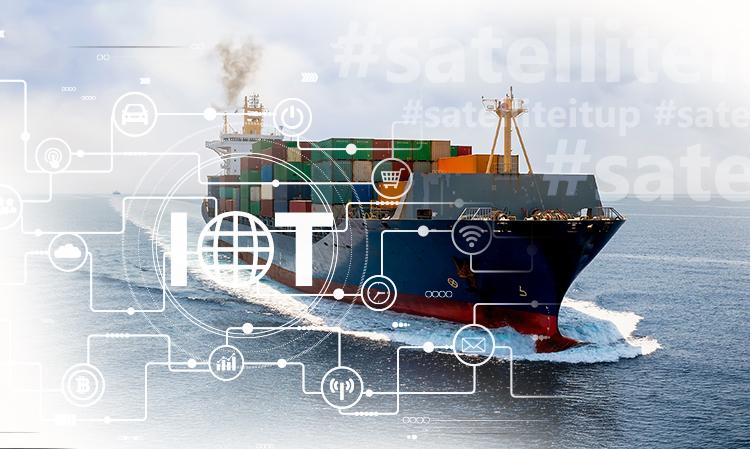Between January 2020 and March 2021, the average daily data consumption onboard a vessel in the global commercial shipping sector has nearly tripled. Inmarsat’s recent report has shown this consumption to grow from 3.4 to 9.8 gigabytes in just a little over a year. The worldwide maritime digital products and services market is reportedly worth $159 billion. A report by Thetius shows that this is 18% ahead of pre-pandemic estimates. This year, the market turnover is already predicted to be three years ahead of pre-pandemic forecasts.
From simple voice applications to complex M2M devices enabling value-added services over satellite connectivity, today IoT solutions can help the maritime sector to identify the most energy-efficient routes, plan the most optimal engine configurations, lower carbon and GHG emissions, reduce fuel consumption (which represents 50-60% of total vessel operating costs), and much more.
The Internet of Things (IoT) technology empowers connectivity between a myriad of objects and the cloud on the internet. Such automation enables end-users to control operations with the simple touch of a button, affecting a variety of parameters that support the decision-making process.
In the maritime industry, IoT can support digital cargo optimisation by reducing empty space from 40% to below 15%. IoT technology takes this process from a physical space to the digital realm after collecting data on container types, weight, engine performance, destination, and more. This critical space and transportation capacity decision-making is easily enabled by offering remote control to the vessel operator.
Real-time data enables the route management process and improves the efficiency of the journey by taking into consideration the often long duration at sea and the rapidly changing environmental conditions along the course of the vessel.

According to an Inmarsat report, leading shipping organisations plan to invest $2.5 million on IoT-based solutions in the coming three years to achieve cost-savings of about 14% over the next five years. Today, connectivity isn’t only about doing more; it is about utilising digital products for smarter workflow, seamless communications, and sustainable environment-friendly processes. IoT-based solutions enable real-time decision-making to optimise routes, vessel functions, and maintenance schedules, and reduce operating costs.
The Industrial IoT at Land and Sea: Maritime report found that 47% of vessel owners collect data for environmental monitoring. As the International Maritime Organisation (IMO) has set targets for the shipping industry to reduce its carbon emissions by 40% by 2030, not only do IoT solutions support compliance and administrative processes, they help to optimise operational efficiency by almost 30% as a result of enhanced logistics, decreased fuel consumption, and improved crew welfare. Sulphur caps, oily water separators, cybersecurity regulations, and SEEMP/EEDI are just a few of the more recent requirements.
As 65% of vessel owners already conduct IoT-based fuel consumption monitoring and 9% plan to introduce it within 12 months, most expect to use IoT fuel monitoring solutions by 2023. This is significant because fuel consumption accounts for more than half of a vessel’s total operating costs.
While earlier voice and data transmissions were dependent on costly VSAT relays, the creation of LEO satellites in the Ka-band has enabled higher data rates and security. Along with 5G capabilities, this is expected to revolutionise connectivity at sea. As of 2021, there are around 13.8 billion IoT units, expected to grow to 30.9 billion by 2025. With this increased IoT technology, vessel data is increasingly being stored in the cloud and enabling faster cloud computing analysis.
Offshore Operations: IoT sensors ensure complete visibility over the fleet. Tracking devices empower vessel operators with comprehensive onshore management, controlling and monitoring remote maritime assets, and safeguarding offshore assets from damage, theft, and unauthorised movement.
Fishing Operations: Smart indicators ensure transparency over fishing activities in local waters. With EEZ alarms and geofencing capabilities, operations can be diverted to authorised areas, side-by-side movements and heading direction can be tracked in real-time, and critical decisions can be supported with accurate concurrent data.
Oil & Gas Operations: Autonomous devices ensure secure and efficient oil and gas operations. In a potentially hazardous and unpredictable environment, access to real-time data for machinery uptime and hours of daily work by onsite resources – both human and equipment – facilitates accurate reporting, timely maintenance, and risk aversion processes.
Safety Operations: Specialised trackers ensure safety for the onboard crew. With individual biometric sensors and ‘man-off-the-board’ trackers, emergencies can be reported to a central point over email, SMS, or voice, and apt response processes can be activated no matter where the vessels or crew operate.

A recent report by GlobalData shows that mentions of IoT in filings of companies in the maritime sector rose 23% just between the second and third quarters of 2021. This is 64% higher than in 2016. In fact, a recent Market Research Future (MRFR) report forecasts that the maritime IoT market will grow at a 6.2% CAGR between 2020 and 2027.
The Asia Pacific region is the biggest market for maritime IoT solutions, being led by the demand for highly advanced naval vessels in India and China. Additionally, sea trade between India, China, Australia, and Japan is also leading to increased demand for maritime IoT solutions.
As the demand for digital solutions across the maritime sector grows, the importance of elevating operational efficiency via network management systems and IoT-based solutions cannot be overemphasised.